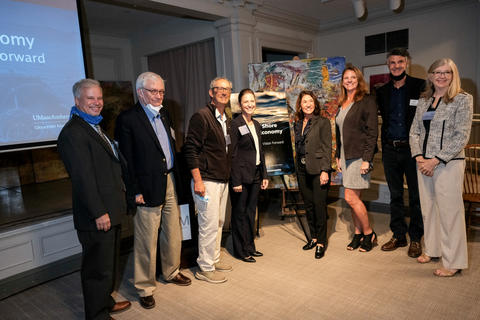North Shore initiative releases blue economy phase 1 findings
UMass Amherst Gloucester Marine Station-led study reveals opportunities for developing resilient, sustainable and equitable strategies for ocean-based economic and social growth
GLOUCESTER, Mass. – Now is the time for North Shore communities to build on their unique strengths to build resilient, sustainable and equitable maritime economic development while also promoting and sustaining ocean ecosystem health. That is among the Phase 1 conclusions of a study led by the University of Massachusetts Amherst’s Gloucester Marine Station about the importance and impact of the Blue Economy on North Shore communities.

The “North Shore Blue Economy Phase I Findings and Vision Forward” report was released by the North Shore Blue Economy (NSBE) Initiative and its findings announced today at the Cape Ann Museum in Gloucester.
To provide a baseline analysis of the area’s demographic and economic data, the initiative engaged with nearly 300 North Shore Blue Economy stakeholders from industry, investment, philanthropy, research, and local, state and federal governments, among others.
Katherine Kahl, professor of sustainable fisheries and coastal resilience at the UMass Amherst Gloucester Marine Station, who leads the initiative with a regional advisory committee, presented the first phase findings with Michael Goodman, professor of public policy and acting provost and vice chancellor of academic affairs at the University of Massachusetts Dartmouth. Goodman led the economic analysis portion of the study while executive director of the University of Massachusetts Dartmouth Public Policy Center, which closed in July 2020. The analysis was completed by Springline Research Group.
“Now is the time to build on our strengths: our fishing, our coastal tourism and recreation, our heritage in ship and boatbuilding, our beaches, our salt marshes, our access to the ocean, our access to Boston, and the incredible sense of place that the people who live in this region have,” Kahl said. “We welcome the involvement of all communities in the region to help assess strategies going forward.”
“We have a once-in-a-lifetime opportunity here to build on these extraordinary assets that we have across coastal Massachusetts which have really defined both our economic history and our cultural history,” said Goodman, who added that North Shore was defined for the study as coastal Massachusetts cities and towns north of Boston from Lynn to Salisbury, divided into two regions, the upper North Shore and the metro North Shore.
The region needs to capitalize on emerging opportunities that presently aren’t large employment sectors, but represent “huge areas of opportunity,” Goodman said, such as the marine science and technology sector.
One such opportunity, Goodman pointed out, is the more than 126,000 people who live in the region but work elsewhere and who are among the most highly educated and highest wage earners in the region.
“We have to make it easier for the talent that already resides in the region to find a way to make a living here,” Goodman said, “and I think some of the opportunities in the Blue Economy are low-hanging fruit in this regard.”
Also in attendance was Massachusetts Lt. Gov. Karyn Polito, who provided an update on how government has assisted the Commonwealth in advancing marine sciences and marine industries. She cited the Salisbury Beach Boardwalk and the commercial wharf at the Salem marina as two examples.
“I hope that this analysis can help to position the region to take the next step towards judicious and wise investments in your capacity to take advantage of this,” Goodman said.
In addition to establishing baseline data, the project’s Phase 1 goal was to identify opportunities to grow the NSBE that are tied to the region’s existing strengths and emerging growth prospects.
There are four intersecting growth sectors that represent billions of dollars in potential, Kahl said: the evolving living resources sector, the developing marine science and technology cluster, the potential for offshore wind in the Gulf of Maine and increased state and federal financial investment for coastal resilience efforts.
“This is our sweet spot. This is a unique set of interwoven opportunities,” Kahl said.
Phase II of the 10-year plan will focus on advancing four broad targets: growing the NSBE network, driving job creation through workforce training and education, marketing the region’s Blue Economy vision, and fundraising and increasing access to capital that will foster entrepreneurship and incubate enterprises and initiatives.
“We have the opportunity to get organized as a region and do more together to identify, target and secure significant funding and build climate resilience into our Blue Economy strategies,” Kahl said. “Imagine a North Shore where, in 10 years, we have a thriving network of hundreds of diverse partners, public and private investment and access to capital for the Blue Economy, workforce training that retains the talent we’ve grown in our region, and a revolutionized sustainable seafood supply chain that reinvigorates our ports.”
The full report, a fact sheet on the Phase I assessment and other materials can be found at www.umass.edu/nsblueeconomy
The NSBE Initiative is led by the University of Massachusetts Amherst Gloucester Marine Station. The NSBE steering committee includes representatives from the Gloucester Economic Development and Industrial Corporation, Greater Cape Ann Chamber of Commerce, City of Gloucester, North Shore Technology Council, North Shore InnoVentures and Essex County Community Foundation. Economic analysis was led by the University of Massachusetts Dartmouth Public Policy Center, which closed in July 2020, and was completed by Springline Research Group. Additional financial support was provided by the Commonwealth of Massachusetts, UMass Amherst Department of Environmental Conservation and the Northeast Climate Adaptation Science Center, with outreach support from the UMass Amherst Center for Agriculture, Food & the Environment.